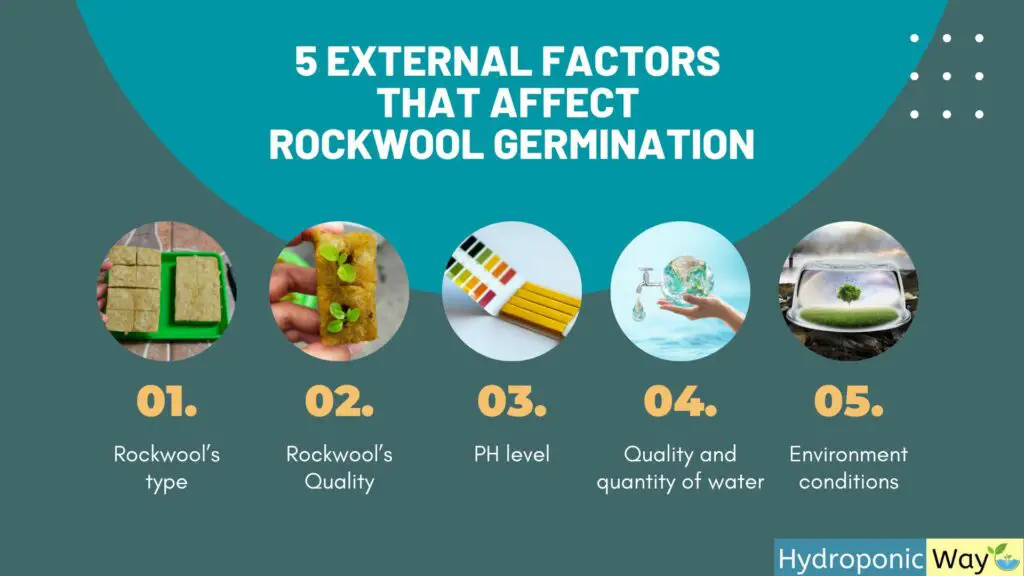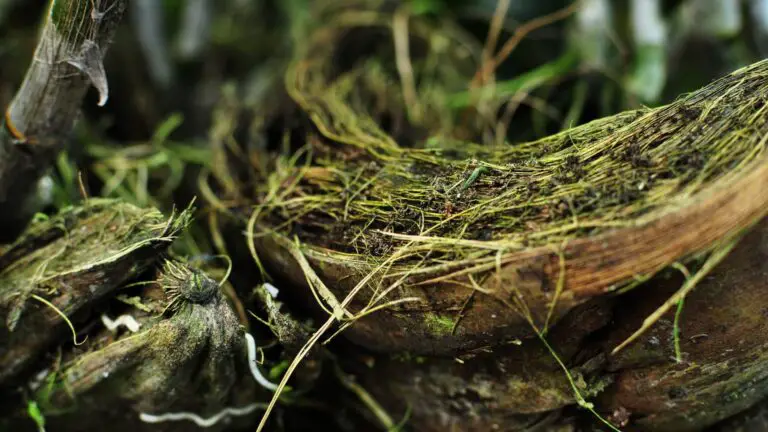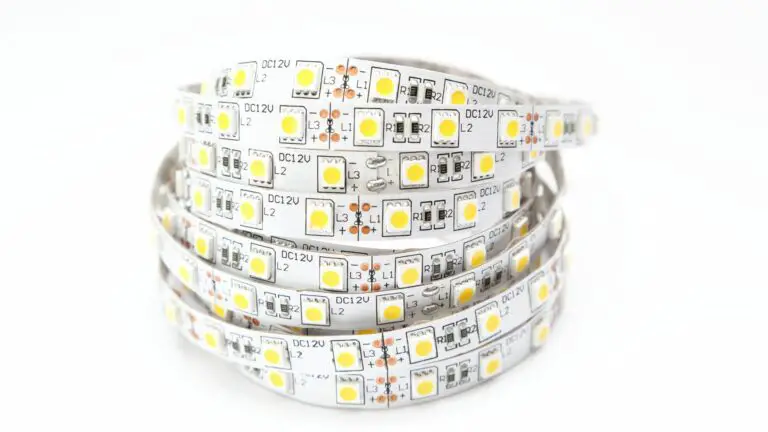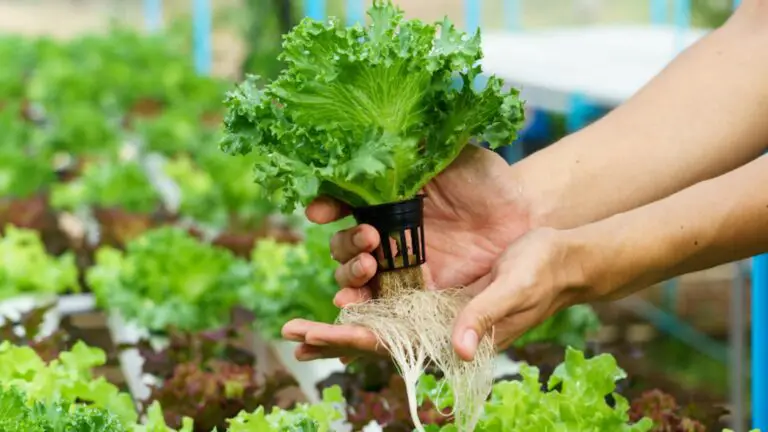5 External Factors Affecting Germination in Hydroponic Rockwool
Disclosure: Your purchases through our links may earn us a small commission, supporting our site’s ability to provide valuable information to our readers. Rest assured, it won’t impact your price. Thank you for your support.
Are you looking to start your hydroponic garden? Make sure you take Rockwool germination into account!
What Is Rockwool, and Why Should You Care?
The Rockwool is a material that has been used in hydroponic systems for decades. It is responsible for the high water retention capacity and lightweight. Rockwool can be found in many products, such as insulation boards used to provide thermal protection or soundproofing, an easily cleaned substrate.
They can be used in greenhouses or nurseries and are a cheap alternative to bark chips when growing plants like strawberries. However, Rockwool requires special care before planting seeds because external factors affect germination, including moisture content.
This article will discuss five essential external factors affecting Rockwool germination, so you know what you need to do before planting your Rockwool.
What Are the External Factors That Influence Rockwool Germination?
The External factors include the type of Rockwool cube, pH level, environmental conditions in which the plants are growing, and the water’s quality and quantity.
1. Rockwool’s type
Rockwool is an exciting and innovative product that has helped farmers improve their yield worldwide.
The different types of rock wool, cube, slab, granulated all come in various dimensions for people who need them differently, such as those experiencing problems with hydroponics. They allow growers to choose the best fits their needs while maintaining high moisture retention so plants do not dry out.
If avoiding transplanting during vegetative growth will help your plant grow, Rockwool slabs may offer more benefits as well without compromising on plant support or weight.
Rockwood is made from basalt or limestone, which significantly influences its characteristics like moisture retention. Rockwool’s lighter weight makes it easier to handle, and its heavier weight helps plants resist gravity.
2. Rockwool’s Quality
Rockwool cubes are a great way to start your plants, and with the proper care, they can thrive! They are sterile and help reduce stress. We can reuse them multiple times. However, Rockwool can be use to germinate six different crops.
However, make sure to use a fresh cube with each new batch of seeds. Be sure to soak the cube for at least 24 hours beforehand when you’re ready to transplant your plants into soil or coco coir. This practice will help your plants get a good start and grow healthy and strong.
3. PH level
Adding a little quantity of sand or gravel to your Rockwool cubes can alter the PH levels to make them more alkaline or acidic as needed. Always be sure to balance the sand and distilled water to avoid adding too much sand and making the environment too alkaline. Too alkaline or acidic PH levels can also impact your seeds during the germination period since they might be harmful to the plant.
The Rockwool cubes should be soaked in the diluted mixture and allowed to dry before planting your seeds. Rockwool has a pH range of 7–8, so make sure you allow plenty of time for dilution before planting your seeds!
In most cases, the ideal pH range for plants is between 6 and 7. However, some plants can grow in a more alkaline or acidic environment. Before germinating it in Rockwool cubes, be sure to research your specific type of plant and its required PH levels!
Related: How to Keep the PH Level of Each Hydroponic Growing Medium?
4. Quality and quantity of water
Quality and quantity of water are essential factors to consider when germinating seeds in Rockwool cubes.
You want to make sure that the water is free from contaminants and has a required pH level for the seeds to grow successfully. If the pH level is too high or too low, it can damage the plant’s roots and inhibit growth.
You can test the quality of your water by using a TDS meter. If the water is too high in contaminants, you can use a water filter to remove the pollutants.
We may use Rockwool cubes for germinating seeds in soil or coco coir. When you’re ready to transplant your plants into these media, make sure the Rockwool cube has been soaked for 24 hours. Then you’ll have a better chance of having more seeds sprout.
You also want to make sure that you’re using fresh and quality water — don’t reuse old water from your reservoir. Old water can contain harmful contaminants that can damage your plants. It’s important to test the pH level and quality of your water regularly so that you can take corrective action if necessary.
5. Environment conditions
If you fail to meet the Rockwool cube germination conditions, you will indeed have a hard time growing things. If you want to be successful, make sure that Rockwool is in an environment with the required lighting, the temperature of the Rockwool, air circulation or oxygen levels in Rockwool, humidity levels in Rockwool. You’ll increase your chances of growing better things if you pay attention to these factor.
- Lighting
Rockwool cubes provide the perfect environment for germination in hydroponics! You can ensure that your plants grow in the healthiest way possible by providing the correct lighting.
Successfully germinated seeds should remain in the dark until they show signs of true leaves and hypocotyls (the stem just beneath the cotyledon leaves).
Once your seeds have germinated, you can move them to an area that gets bright light but not direct sunlight. The Rockwool cubes will act as a protective shield around the young shoots of the plants for several weeks until they are mature enough to grow independently.
Make sure to use metal halide or high-pressure sodium lights during the vegetative growth stage for plants that need a lot of light.
If you’re growing tomatoes, you’ll need more red spectrum lights that simulate sunlight due to the increased red spectrum light requirement.
- The temperature of the growing medium
Temperature is a crucial factor in germination rates, and luckily, most plants thrive in a temperature range of 75–85°F. With a relative humidity of 50–70%, you’re well on your way to healthy, thriving plants.
Certain plants prefer different temperature ranges. For example, cotton, cucumbers, and peas germinate better in warmer temperatures with a humidity level between 40–50%. However, lettuce can germinate at 65°F but won’t do as well at 68°F. On the other hand, peppers and eggplants thrive in temperatures around 80°F.
Make sure your Rockwool germination is up to the requirement by checking your seed package for the ideal temperature!
If you have Rockwool germination problems, look for seeds that won’t sprout due to being too cold or hot. Make sure your Rockwool growth kit doesn’t become excessively cold or heated!
- Air circulation or oxygen levels in the Rockwool cubes
Rockwool cubes provide the perfect environment for germination in hydroponic gardens! By following a few simple tips, you can ensure that your germination process is successful.
First, it’s important to make sure that the oxygen levels are high in your garden to help your plants get the necessary oxygen they need to germinate and grow.
If you notice that the oxygen level is dropping, you can increase it by adding an air stone to your hydroponic system.
In addition, make sure to feel the Rockwool cubes before purchasing them to ensure that they are fresh. If the cubes feel light, there is more air in the Rockwool, which can cause seeds not to germinate or rot inside Rockwool cubes.
Ideally, your Rockwool should have enough oxygen level. You can achieve this by keeping the water level at the top of the Rockwool cube and ensuring good air circulation around the cube.
- Humidity levels in the Rockwool
Rock wool cubes provide an ideal environment for seedlings. They can increase your plant’s chances of survival in several ways, including by creating a well-draining, light, and air-permeable material that maximizes oxygen and water input, allowing for more excellent root development and less chance of disease.
However, humidity levels can have a significant impact on germination success rates.
Like lettuce and spinach, some plants have a short germination period of two to three days. You will want to keep the humidity levels around 50–70% for these plants.
Other plants, like tomatoes, take a little longer to germinate and can take five to ten days. You will want the humidity levels to be around 65–75% for these plants.
Finally, some plants don’t like high humidity levels and should be kept in a 30–40% low-humidity environment.
If the humidity level in your system is too high, algae can grow on your Rockwool cubes. This might not only affect the germination process, but it may also harm your plants. If your rock wools develop algae because of the moist environment within your hydroponic system, use them right away before algae spread further and cause additional issues.
The best way to ensure your plants have a successful start is by keeping humidity levels in a required range.
The plants require more moisture in up to 70 percent humidity levels during the vegetative stage. The humidity should be lowered to below 50 percent as the flowers bloom and mature to prevent further disease. The humidity level should remain at 40% throughout the final stages of blooming [Source].

Appropriate Practice Is Necessary to Achieve an Excellent Germination Rate.
Rockwool is a material that provides your plant with the perfect growth environment. However, several external factors can affect Rockwool growth. Some of these include the type of Rockwool cube, pH level, and the water’s quality and quantity.
Also, we need to ensure they are at their appropriate ranges of environmental conditions such as light, temperature, humidity level, and oxygen level. Rock wool germination will improve by paying attention to different factors of rock wool and practicing appropriate ways.
Thank you for reading!
Also, read:
Cheap Grow Lights Alternatives Used in Indoor Hydroponics
Pros and Cons of Drip Hydroponic System
If you are looking to buy Rockwool for your garden click this link to select the best one suited for you.
Also you can buy 3-in-1 TDS Temperature & EC Meter, Digital Water Tester, Ultrahigh Accuracy Water Quality Tester for Hydroponics to keep monitoring the germination process as explained above.




